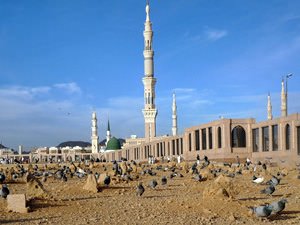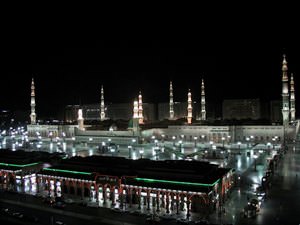
Medina is known throughout the world for its unique Muslim shrines. The main guests of this city are pilgrims who come here from all over the world all year round. Most of the pilgrims visit Medina during religious holidays, as the world's largest celebrations of this kind are held here. For the townspeople, the observance of religious traditions has become an essential component of everyday culture. The main part of traditions and customs is associated with religious canons. Entrance to the territory of the holy city is allowed only to people of the Muslim faith. During their stay in the city, they need to follow a number of strict rules.
Medina's main sights are world-famous Muslim shrines attracting pilgrims from all over the world. The main symbol of the holy city is Al-Masjid an-Nabawi, a mosque famous in legends. …
Open
Locals consider their hometown to be clean in every sense of the word, any manifestations of destruction are prohibited here. In Medina, you cannot pick flowers and break tree branches, as well as show a negative attitude towards animals. If the purpose of the trip is not major religious holidays, it is recommended to avoid them. Many pilgrims always flock to Medina on such days, so it may be not very comfortable to admire the local historic sights and monuments of modern architecture.
The life of the townspeople is very interesting and authentic. Literally all its spheres have some Interesting features. Colorful markets have been operating in the city for several hundred years. They have become one of the townspeople's favorite places for leisure and meetings. Walking through the colorful rows, they meet their relatives and friends, and just have a good time. Cozy restaurants and cafes are hidden right amidst the rows, many come here specifically to have a cup of fragrant coffee. The whole market is shrouded in the aromas of traditional spices, which are the most important component of the local gastronomic culture. Copyright www.orangesmile.com
Medina is the largest pilgrimage center in the world. For this reason, the city cannot offer a variety of entertainment venues. Nevertheless, its guests can diversify their leisure …
Open
Gastronomic traditions typical of the city deserve a separate mention since religious traditions had a great influence on their formation. For cooking, local residents use only halal products - prepared in a certain way and not containing any harmful ingredients. According to religious traditions, it is forbidden to eat pork in Medina, so dishes from this type of meat are not served in local restaurants. The main meat product is lamb, and the slaughtering of animals is carried out according to strict halal rules. The main goal of the proper livestock slaughter is to ensure that the animal does not feel pain and fear at the time of the killing. This method allows to significantly reduce the content of adrenaline in the meat, which has a good effect on its taste and makes the product healthier. It is noteworthy that halal food, the traditions of which originated in Saudi Arabia, has become popular in various countries around the world. It is now preferred not only by believers of the Islamic faith but also those who care about their health.
![Madinah, Al haram at night Madinah, Al haram at night]()
Commitment to national crafts is another important component of regional culture. One can appreciate the variety of traditional crafts and arts while walking through local markets, where local craftsmen and artists present their best products. In Medina, you can buy chic handmade carpets, as well as exquisite fabrics for sewing and typical local clothes. Goods made of copper are very popular with tourists. It is used by local masters to make beautiful tableware, candleholders, and other household items. Ladies should pay attention to copper jewelry - local women wear them not just for the beauty but also for health improvement. In Medina's craft workshops, they make wonderful crafts from wood. You can also buy traditional musical instruments at local markets.
1. If exploring religious shrines is not the only purpose of your trip, the best time to visit Medina is between November and February. During this period, there is the lowest concentration …
Open
Such a distinct way of life and strict observance of religious traditions could not but affect the character of local people. They have a very quiet and peaceful temper, it is not customary to talk loudly and demonstrate emotions here. Traditions of wearing covered clothes have also been preserved in Medina over hundreds of years. The rules regarding women's clothing are particularly conservative. Despite the hot weather, they always wear shawls and long dresses. Only eyes and hands can be among the body parts that are not covered with fabric. Travelers who want to show respect for the local culture and inhabitants of the holy city should take into account these simple rules.
Medina - guide chapters
1
2
3
4
5
6
7
National traditions of Saudi Arabia

Sharia is intolerant of any other religion. It is forbidden to publicly preach, build temples or even pray. This can be done only in private homes only by representatives of those faiths that are officially allowed. Their list is approved by the Ministry of labor. Any public meetings other than Muslim prayer meetings are prohibited, even if it is a normal picnic.
…
Open
 Medina is known throughout the world for its unique Muslim shrines. The main guests of this city are pilgrims who come here from all over the world all year round. Most of the pilgrims visit Medina during religious holidays, as the world's largest celebrations of this kind are held here. For the townspeople, the observance of religious traditions has become an essential component of everyday culture. The main part of traditions and customs is associated with religious canons. Entrance to the territory of the holy city is allowed only to people of the Muslim faith. During their stay in the city, they need to follow a number of strict rules.
Medina is known throughout the world for its unique Muslim shrines. The main guests of this city are pilgrims who come here from all over the world all year round. Most of the pilgrims visit Medina during religious holidays, as the world's largest celebrations of this kind are held here. For the townspeople, the observance of religious traditions has become an essential component of everyday culture. The main part of traditions and customs is associated with religious canons. Entrance to the territory of the holy city is allowed only to people of the Muslim faith. During their stay in the city, they need to follow a number of strict rules.
 Open
Open
 Open
Open
 Commitment to national crafts is another important component of regional culture. One can appreciate the variety of traditional crafts and arts while walking through local markets, where local craftsmen and artists present their best products. In Medina, you can buy chic handmade carpets, as well as exquisite fabrics for sewing and typical local clothes. Goods made of copper are very popular with tourists. It is used by local masters to make beautiful tableware, candleholders, and other household items. Ladies should pay attention to copper jewelry - local women wear them not just for the beauty but also for health improvement. In Medina's craft workshops, they make wonderful crafts from wood. You can also buy traditional musical instruments at local markets.
Commitment to national crafts is another important component of regional culture. One can appreciate the variety of traditional crafts and arts while walking through local markets, where local craftsmen and artists present their best products. In Medina, you can buy chic handmade carpets, as well as exquisite fabrics for sewing and typical local clothes. Goods made of copper are very popular with tourists. It is used by local masters to make beautiful tableware, candleholders, and other household items. Ladies should pay attention to copper jewelry - local women wear them not just for the beauty but also for health improvement. In Medina's craft workshops, they make wonderful crafts from wood. You can also buy traditional musical instruments at local markets.
 Open
Open
 Sharia is intolerant of any other religion. It is forbidden to publicly preach, build temples or even pray. This can be done only in private homes only by representatives of those faiths that are officially allowed. Their list is approved by the Ministry of labor. Any public meetings other than Muslim prayer meetings are prohibited, even if it is a normal picnic.
… Open
Sharia is intolerant of any other religion. It is forbidden to publicly preach, build temples or even pray. This can be done only in private homes only by representatives of those faiths that are officially allowed. Their list is approved by the Ministry of labor. Any public meetings other than Muslim prayer meetings are prohibited, even if it is a normal picnic.
… Open 

